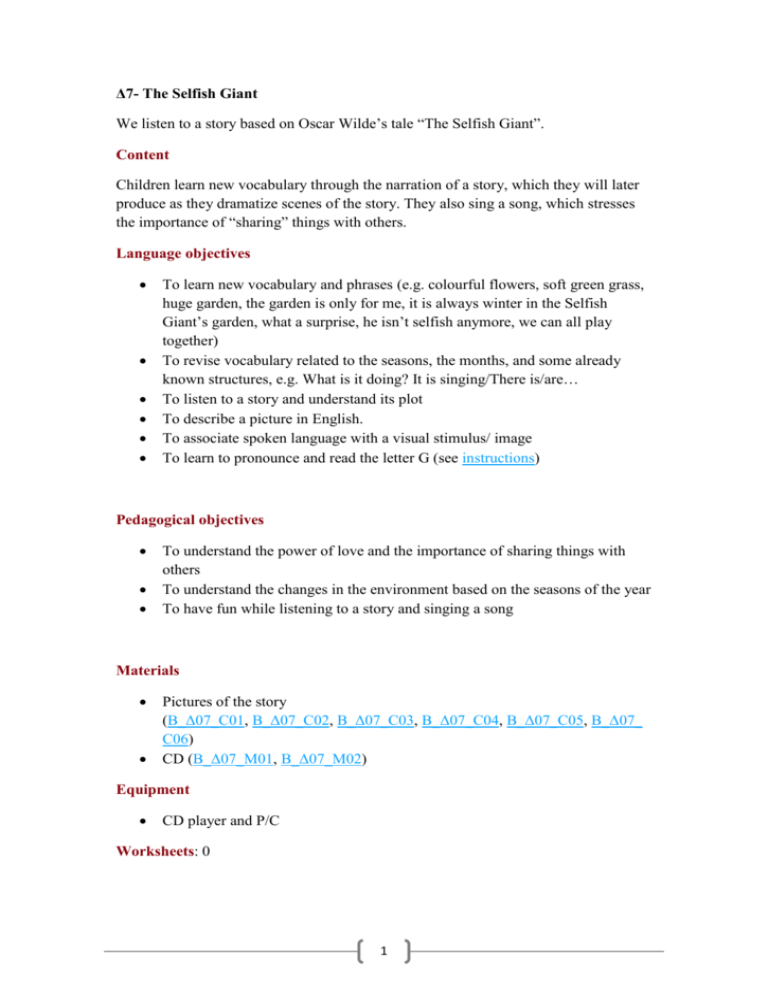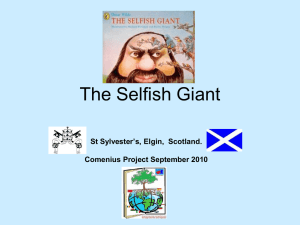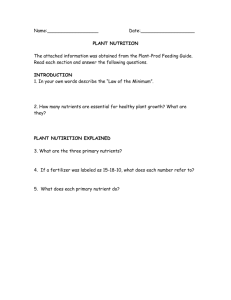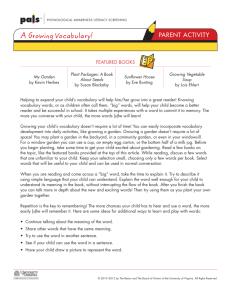B_D07_The selfish giant
advertisement

Δ7- The Selfish Giant We listen to a story based on Oscar Wilde’s tale “The Selfish Giant”. Content Children learn new vocabulary through the narration of a story, which they will later produce as they dramatize scenes of the story. They also sing a song, which stresses the importance of “sharing” things with others. Language objectives To learn new vocabulary and phrases (e.g. colourful flowers, soft green grass, huge garden, the garden is only for me, it is always winter in the Selfish Giant’s garden, what a surprise, he isn’t selfish anymore, we can all play together) To revise vocabulary related to the seasons, the months, and some already known structures, e.g. What is it doing? It is singing/There is/are… To listen to a story and understand its plot To describe a picture in English. To associate spoken language with a visual stimulus/ image To learn to pronounce and read the letter G (see instructions) Pedagogical objectives To understand the power of love and the importance of sharing things with others To understand the changes in the environment based on the seasons of the year To have fun while listening to a story and singing a song Materials Pictures of the story (B_Δ07_C01, B_Δ07_C02, B_Δ07_C03, B_Δ07_C04, B_Δ07_C05, B_Δ07_ C06) CD (B_Δ07_M01, B_Δ07_M02) Equipment CD player and P/C Worksheets: 0 1 ABC Picture for the particular letter (G_C) CD/ Songs for the specific letter (G_M) Worksheet (G_W) Suggested online material Song http://www.youtube.com/watch?v=pu2C4xylXwY&feature=related Suggested time: 4 teaching hours Suggested procedure Step 1 As the concept “selfish” is difficult for children to understand at this age, it can be introduced by asking students questions in Greek, such as “How would you call someone who doesn’t like to share things?”, “How would you call a person who wants everybody to obey them?”. Thus, we elicit the word “selfish”. Then, we tell children that we are going to narrate a story about a selfish giant who didn’t want to share his garden with anybody. We show them the picture of the giant ( B_Δ07_C02) and tell them: - Look! This is the Selfish Giant. We ask them to repeat the name of the hero in the story and guess how he usually behaves. We ask, for instance: - Does he share his things? - Has the Selfish Giant got any friends? - Does the Selfish Giant love people?,etc. Step 2 We stick the pictures of the story on the board (B_Δ07_C01, B_Δ07_C02, B_Δ07_C03, B_Δ07_C04, B_Δ07_C05, B_Δ07_C06) asking children to tell us what they can see. We encourage children to tell us the words they already know in English. We present words and key phrases (e.g. a huge garden, colourful flowers, soft grass, the frightened children, a hole in the wall). We try to enhance children’s understanding through movements, facial expressions, miming feelings, etc and we ask them to repeat the new words, while asking questions, such as: - Where are the children? Is the garden big? Is it beautiful? What season is it here? Is it Spring/ Autumn/ Summer/ Winter?, etc. Step 3 After having put all the pictures of the story on the board, we ask children to relax and listen to it. We narrate the story or listen to it on the CD (B_Δ07_M01, script). We use techniques to help enhance student understanding (e.g. 2 colouring the voice, changing intonation, miming, facial expressions, etc). We narrate the story slowly pointing at the pictures we have put on the board and without interrupting to explain anything. If children wish, we can narrate the story or listen to the CD once more. Step 4 We number the pictures we have put on the board and tell the class some phrases describing each picture in a jumbled order. We ask them to think of the content of the story, to look at the pictures carefully and tell us which picture our phrases refer to. For the first picture we use the phrases: “There are tall fruit trees, colourful flowers and soft green grass in it” and “We’re so happy here”. For the second picture: “One day the Giant comes back from his trip” and “The children are scared and run away”. For the third picture: “The next day the Giant builds a huge wall around the garden” and “The garden is only for me”. For the fourth picture: “The little children sneak into the garden” and “They climb happily on the trees”. For the fifth picture: “The Selfish Giant helps one little boy climb up the last frozen tree in the garden” and “Spring is here at last” shouts the Giant. For the sixth picture: “It’s your garden, and we can all play together” and “And they live happily ever after”. Step 5 We ask children to dramatize the story of “the Selfish Giant”. We divide them into groups and ask each group to dramatize a picture of the story. So, the number of groups must be the same as the number of pictures. Based on the picture they have to dramatize, each group produces small phrases and dialogues with our help. When all groups are ready, they come to the front and play their part (see dialogues in the educational material) Optional: Each group can draw a picture representing the dialogue they have played. All the drawings can be bound in a booklet with the picture of the Selfish Giant as a cover. Step 6 We watch this video with the children. We pause the video on the first scene and ask questions like: “How many children are there?” and then “How many ice creams are there?”. We keep on asking questions and reach the conclusion that it is very important to share things and not be selfish like the giant. For instance, we ask: -Is the boy with the ice-cream happy? -Is the girl without the ice-cream happy? -What can the boy do? We elicit the answer: He can share his ice-cream. 3 We ask children to repeat the phrase and then we show the rest of the video encouraging children to sing the refrain of the “Sharing song” (B_Δ07_M02, lyrics). Together we repeat the refrain of the song while sharing something. For instance, we can give candies, chocolates or fruit to children as we sing the song showing them the value of sharing in practice. Educational Material (Click on the archives to download the material) Pictures B_Δ07_C01 B_Δ07_C05 B_Δ07_C02 B_Δ07_C03 B_Δ07_C06 4 B_Δ07_C04 ABC G_C Worksheet ABC G_W Audio Material B_Δ07_M01: The Selfish Giant B_Δ07_M02: Sharing song G_M: Letter G The script of the story The Selfish Giant based on the Oscar Wilde’s tale Picture 1: Every afternoon lots of little children, boys and girls, come to play in the Giant’s garden. It’s a very big garden- huge, like the Giant- but so beautiful. There are tall fruit trees, colourful flowers and soft green grass in it. ‘We’re so happy here’, the children cry while playing all sorts of different games- with their rackets, with their ball, with their toys. 5 Picture 2: One day the Giant comes back from his trip. He looks mean. He stands in the middle of the garden and shouts in an angry voice. ‘What are you doing here?’ ‘This is my garden and you can’t play in it’. The children are scared and run away. Picture 3: The next day the Giant builds a huge wall around the garden. ‘Nobody can come in now’, he thinks to himself. ‘The garden is only for me’. He’s a very selfish Giant. Time passes fast and spring comes everywhere. But not in the Selfish Giant’s garden. Then, summer comes everywhere. But not in the Selfish Giant’s garden. And then Αutumn comes. But again, not in the Selfish Giant’s garden. It is always Winter in the Selfish Giant’s garden. Picture 4: One day the little children find a small hole in the Giant’s wall and sneak into the garden. They climb happily on the trees and what a surprise! The trees are now full of flowers, the grass is green again and the birds are singing the most beautiful music in the world. Picture 5: The Selfish Giant wakes up to the lovely music he can hear. He goes to his garden and helps one little boy climb up the last frozen tree in the garden. And suddenly the tree is filled with green leaves and colourful flowers. ‘Spring is here at last’ shouts the Giant. He isn’t selfish anymore! Picture 6: ‘There’s no wall around my garden’, the Giant says to the children. His voice is so sweet now. ‘It’s not my garden anymore’, ‘It’s your garden, and we can all play together’ adds the Giant. And they all live happily ever after. Possible dialogues for dramatization Picture 1 Look! It’s a big garden! It’s beautiful! - There are flowers and trees! Let’s play! Picture 2 - Oh no! The giant! - What are you doing here? - We’re playing. 6 - Go away! Hurry up! Run! Picture 3 Look! A wall! - We can’t go in the garden. - We can’t play now. - The giant is selfish. Picture 4 Look! A hole in the wall! Let’s go in the garden. It’s Winter here! Let’s climb up the trees. Picture 5 It’s Spring now! - Come little boy! Let me help you climb up the tree. - Thank you Mr Giant. - My garden is beautiful again. Picture 6 - Can we play in your garden now? It isn’t my garden. It’s your garden! - Thank you Mr Giant. You’re so kind. - You aren’t selfish anymore! - You like sharing! Let’s play together. LYRICS Sharing song It’s mine But you can have some With you I’d like to share it Cos if I share it with you You’ll have some, too. Gg A goat in the garden, A goat in the garden, A goat in the garden Is eating grass! 7








